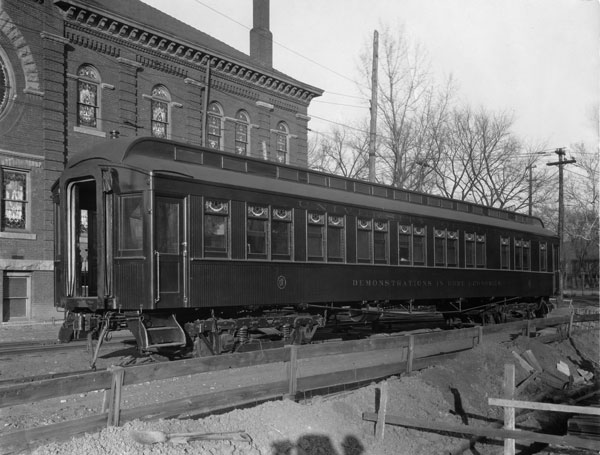If people don’t flock to the agricultural college, take the agricultural college to the people.
In February and March of 1911, the College of Agriculture Extension Service operated two special cars furnished by the Illinois Traction system, sharing knowledge about cultivating soil and raising agricultural products in the state of Illinois. Professor Fred L. Charles, University specialist in teaching agriculture, directed the program. He was joined by Professor J.P. Gilbert of the School of Education, L.R. Lang of the dairy department, L.D. Hall of animal husbandry, Professor D.O. Barto who specialized in poultry, and J.E. Whitechurch of the soils division.[1]

Elementary agricultural education was distributed without cost to various district school students, and in villages, towns, and cities on the line of the Illinois Traction system. Tours ran two weeks and the cars stopped at each town or school district on the route, decorated with streamers advertising the project as the “University Special to Rural Schools.”[2] One car transported chicken coops and poultry equipment, soil charts, and object lessons; the other car carried sheep, livestock charts, and samples of meat. Instructors lectured on various subjects pertaining to agricultural methods, the cultivation of soil and crops, the raising of poultry and farm animals, dairy interests, and the extermination of insects and rodents. With such a short demonstration time, each instructor spoke briefly on their topic that most appealed to children. Professor D.O. Barto “had a great number of the pets [chickens] with him and he treated them as if they were his good friends, calling each by name and talking to them in a manner that would impress children.”[3]
Although meetings were geared towards school children, veteran farmers turned out is such numbers that speakers utilized nearby sand piles, boxes, and rolls of wire as platforms. The event in Illiopolis had such a large crowd that the meeting adjourned to a warehouse to accommodate the overflow. As of March 9, 1911, Granite City held the attendance record with 1,200 people, 800 of which were children. The “little college on wheels” met with greater success than anticipated with over 10,000 people gathered at stops along the route.
Audience members oftentimes drove 10-12 miles and walked up to three miles to observe the popular university lectures. An unanticipated scheduling error led to twenty-five children passed by at Whitmore siding. Not wanting to miss the novel educational opportunity, the children trudged one-half mile through the snow to board the train at Lanesville. According to the Illinois State Journal, the university special to rural schools was unique, “the first of its kind ever attempted on an electric line, and likewise the initial effort to carry such special instruction to the rural school pupils exclusively.”[4]

The original Extension Service traveling education course was such a resounding success, the College of Agriculture continued to run various education and demonstration trains throughout the region through the early 1930s, including a Colver Leaf Dairy Train in 1923, Better Dairy Sire Train in 1925, Calf Club Train in 1926, Dairy Bull Train in 1927, Soil and Soybean Special in 1927, Alfalfa-Sweet Clover Train in 1927, Better Dairy Sire Train in 1928, Poultry Sanitation Exhibit in 1928, Soil Testing Train in 1929, Dairy Special in 1929, and the Alfalfa Special Train in 1930.[5]
[1] “Education Work Goes on Wheels,” Champaign Daily News, March 9, 1911.
[2] “School on Wheels Arrives in City,” Unknown, Agricultural Extension Service Historical Material, Record Series 8/3/14, University of Illinois Archives.
[3] “Children Given Chance To Hear,” Champaign Daily News, March 10, 1911.
[4] “Seed and Soil Trolley Car in Sangamon Today,” Illinois State Journal, February 28, 1911.
[5] Agriculture Extension Service, Educational Brochures, and Publications Lists, “Demonstration Trains, 1926-32,” Record Series 8/3/805, University of Illinois Archives.